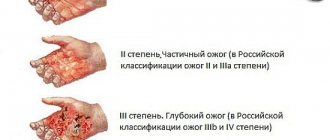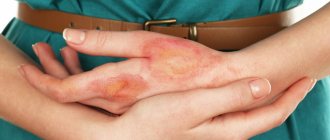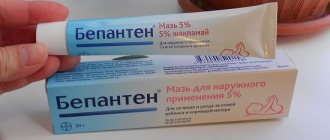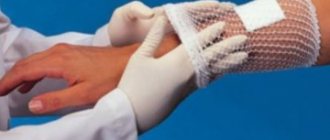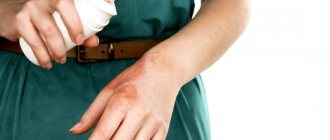When exposed to chemicals or high temperatures, skin injury occurs.
Many people have had personal experience with burns.
But, unfortunately, not many people know what needs to be done after they occur.
Burns: treatment at home - types and first aid
There are several ways to get a burn, which is why they can be divided into several types:
1. Thermal burn - occurs due to the action of steam, fire, hot liquid on human skin.
2. Electrical - from the name it is clear that it occurs after contact with lightning or electrical appliances.
3. Chemical - close contact of the skin with irritating chemicals.
4. Radiation - usually occurs due to prolonged exposure to the sun or solarium.
Regardless of what caused the injury, the resulting skin is still irritated, thereby causing severe pain and redness.
Degree of burns
There are many reasons that contribute to the formation of burns, but you cannot begin treatment without establishing its exact degree. Conventionally, they can be divided into first, second and third degree burns.
First degree burn
Minor damage to the skin can be classified as first degree. Slight redness appears on the skin, and the person feels slight pain. There is no need to hospitalize the patient, since he can be treated at home.
Second degree burn
This degree is characterized by penetration of the burn deep into the skin. Not only redness occurs, but also blisters filled with clear liquid. As a rule, they appear after scalding with a hot liquid, or after contact with chemicals. After treatment is carried out, scars and scars may remain. You should definitely know that if the burn area is larger than your palm, then you should definitely contact a specialist. Treatment can be carried out at home using pharmaceutical preparations.
Third degree burn
This is the most dangerous level. After receiving it, the integrity of the skin is destroyed, and it is possible that nerve endings and subcutaneous tissues will be affected. You can get burned after contact with electricity or chemicals. In this case, the patient’s condition can be either severe or moderate. Treatment can only be carried out in a hospital. Skin grafts are almost always required.
Using soda and salt
Using soda
This product has an alkaline environment. Due to its chemical structure, soda is a good remedy for skin damage caused by chemical agents. When used after receiving burns of a different degree, soda is no less effective. When used correctly, it has the following effects:
- disinfectant;
- anti-inflammatory;
- analgesic.
Thanks to these properties, soda is used for burns and small wounds, when there is no high risk to life.
Applications of sodium chloride
It is strictly not recommended to use salt on burns.
Sodium chloride has no beneficial effect when applied to a wound. When using salt, discomfort increases, and sometimes other consequences arise:
- edema;
- a rash forms;
- blisters appear;
- some tissues die.
The reasons for its appearance are related to the structure of the substance: it contains residues of strong acids and bases. These consequences arise if the reagent is used as an independent substance. It may be contained in minimal quantities in some medications. It follows that salt should not be used as the main remedy, but in tandem with others it enhances their effectiveness.
How to give first aid
After a person has received a burn of any degree, it is important to provide him with first aid as quickly as possible in order to at least somehow alleviate the condition. Moreover, how competently it is provided depends on further recovery.
The most important thing is to calm the victim and yourself. After all, only a collected person can carry out the necessary pre-medical measures. Then you need to do the following:
1. Stop the patient’s contact with the source of high temperature. Be aware that if it is under electric current, do not touch it under any circumstances. To do this you need to take any isolated object. If, after this contact is stopped, the tissue continues to deteriorate, be sure to apply something cold to it for about 15 minutes.
2. Give a pain reliever as well as an anti-inflammatory.
3. Treat the damaged area and apply gauze to it.
4. It is recommended to treat thermal or chemical burns with running water.
For chemical burns, only a doctor can provide the necessary assistance. But if it is not very large, rinse it with cold water.
After first aid has been provided, wait for the ambulance to arrive. Be sure to tell the specialists about the measures you took and what medications you gave.
Initial processing
The rate of healing of burns depends on their treatment immediately after injury. A burned hand or finger with a 1-2 degree thermal burn should be placed under running cold water for several minutes. This will help normalize blood circulation and relieve pain; Also, lowering the temperature will not allow the tissues at the border with the damaged area to heat up.
Ice should not be applied to burns: too low a temperature will injure the tissue.
You cannot independently remove adhered foreign fragments from the burned surface, touch the wound with your hands again, or pierce blisters. The latter save the wound from bacteria; After some time, the blister will open and heal on its own. It is important to avoid other common mistakes.
- Rubbing a burn with cotton can cause cotton fibers to stick to the surface of the wound. For processing you need to use a sterile bandage or gauze.
- Do not apply creams, butter, or sour cream to a fresh burn. This interferes with cooling.
- Vinegar, soda, alcohol tinctures, iodine, potassium permanganate will only increase the damage.
The best thing to do in case of a severe burn is to treat the wound with diluted solutions of disinfectants: 1% hydrogen peroxide, furatsilin, chlorhexedine digluconate, 3% boric acid solution. After washing and drying with sterile wipes, apply a bandage to the wound. You can numb the burn by taking Ibuprofen, Paracetamol or another NSAID.
Features of sun and chemical burns
Some types of injuries require special treatment, which will not only speed up wound healing, but also avoid dangerous consequences. So, for sunburn, compresses made of sterile gauze soaked in cool water help: they are changed as they warm up. During the treatment period, you should not use alkaline soap, rub with washcloths and scrubs, or apply fat, petroleum jelly, or alcohol-containing products to the skin.
Chemical burns require thorough washing of the affected area: substances such as alkalis do not form a scab and continue to destroy tissue. The procedure should last 15-25 minutes. It is impossible to try to neutralize reagents with acid or alkali due to the release of heat that will certainly occur during a chemical reaction.
In case of a burn with quicklime, the skin is first cleaned with a swab or brush, and washed only after the reagent is completely removed.
In no case should quicklime be washed off with water: the substance reacts with it and becomes alkali.
If you suffer a chemical burn during depilation, you should refrain from using the same cream again, do not wear tight clothing, and do not expose the area to sunlight. You should not sunbathe if you have burns from laser hair removal. Such injuries are rarely serious and can usually be treated with healing ointments without seeking medical attention.
Features of burns in certain areas
Sometimes boiling water or inadvertently ingested chemicals cause damage to the surfaces of the tongue, throat and esophagus. If a person receives such a burn, the affected area needs to be cooled. This is done in the same way as for a burn of a finger: with running water for a burn of the tongue or small sips of cold liquid to relieve a sore throat. If the case is not serious, you can rinse your mouth and throat with a decoction of chamomile, apply ointments to the tongue to treat diseases of the oral cavity: Metrogyl, Cholisal, Dental.
If your eyes are burned by a quartz lamp, you should immediately consult a doctor. There is no need to rinse or rub your eyes; Before the appointment, it is important to be in a darkened room and use sunglasses. Drops are prescribed for such injuries: painkillers, anti-inflammatory, antibacterial.
Sometimes a nail burn develops when using an ultraviolet lamp to dry varnish or choosing low-quality products for manicure. Signs include burning, nail discoloration, and redness of the skin. Treatment for such lesions is similar to treatment for skin burns.
What you should never do
If first aid is not provided correctly, serious complications can occur. which will subsequently affect treatment. Therefore, under no circumstances do the following:
1. There is no need to lubricate the damaged areas with vegetable oil.
2. Do not use medications that contain alcohol.
3. Blisters should not be opened independently.
4. If there are pieces of clothing left on the wound, do not try to remove them.
5. Don't use urine.
Remedies for burns at home: pharmaceutical preparations
It is believed that the best remedies for burns at home are pharmaceutical preparations. Depending on the stage of the disease, there are several effective remedies:
Ointments
This is an effective remedy used for thermal burns. Poignon-iodine is especially popular; the iodine content in the ointment is high. In addition, the ointment contains special preparations that promote rapid tissue healing.
Another effective ointment is Procelan. In addition to good bactericidal properties, it promotes the healing of burns. The ointment also contains analgesic components that relieve pain.
Aerosols and sprays
They are used for severe burns. The spray can be quickly and easily sprayed onto the skin, while avoiding painful contact with it.
To treat a burn, doctors recommend using aerosols for external use containing dexpanthenol, which has a healing and anti-inflammatory effect. This component is included in the composition of the European quality medicine - “Panthenolspray” aerosol for external use. The drug has an anti-inflammatory effect, improves tissue regeneration, and is quickly absorbed (absorbed) by the skin. There are no age restrictions, individual intolerance is possible, use in children should be done under adult supervision. You need to be very careful when buying the drug at the pharmacy, because... There are a huge number of analogues on the market, the packaging of which is often visually similar to the packaging of the original medicine - “Panthenolspray” aerosol for external use
The original medicinal product (“Panthenolspray”) aerosol for external use is sold in white packaging, with orange letters and a smiley face next to the name of the drug. The new packaging (from 2020) bears the “made in Europe” sign.
Anti-burn dressings
For example, the Apollo bandage is impregnated with a special solution that numbs the wound.
Special adhesives
The most popular cream is Argakol. It has a fairly strong antimicrobial effect. After it dries, an airtight film forms on the skin.
Many people believe that the best remedies for burns at home are also folk methods. But we'll talk about this a little lower.
How to treat a burn at home: folk methods and remedies
It should be understood that home care for burns cannot completely replace traditional treatment. If you have a severe burn, second or third degree, do not self-medicate under any circumstances. The recipes given below help when the area and depth of the burn is not large. The use of oil products is possible only a few hours after injury. After getting a burn, immediately cool the affected area under running water. If the burn is very small, then after water it can be wiped with vodka or cologne.
Elimination of scalding components
The very first action that needs to be taken to provide assistance is to quickly eliminate the effect of burning factors. First aid for a fire burn should begin with this. To do this, remove clothes and all items that easily heat up. After this, they proceed to cooling the affected epidermis with copious amounts of cool water. You can also apply a cold compress.
Cooling
First aid for a hot water burn is cooling. The effect of cooling compresses should not exceed 30 minutes. It is removed for 20 seconds from the affected tissues and applied back. This is done to prevent skin hypothermia. The burn victim is seated or placed in a position so that the damaged area is higher than the uninjured surface of the body.
Treatment of the wound and application of a bandage
After eliminating the painful manifestations of the injury, they begin to treat the wound and bandage it. To prevent infection and completely relieve pain, the following means are used:
- antiseptics;
- local anesthetics;
- products based on dexpanthenol;
- Olazol - a spray that has a restorative effect, sea buckthorn oil and chloramphenicol;
- Sulfargin is a drug containing silver ions.
For minor injuries of the first stage, you can use the drugs from the given list of medications. If an injury of the second degree of severity occurs or it affects a fairly large area, then sprays are preferred. This is a good burn remedy that can be used at home. They must be sprayed onto the entire wound, holding the bottle level. After which it is necessary to apply a sterile cloth, tightening it slightly. In medical practice, there are 3 types of dressings:
- Dry. Apply dry cloth that has been sterilized.
- Wet-drying. The wound is covered with a cloth, as with a dry bandage, but it is first moistened with the necessary product.
- Ointment. They operate on a different principle. For their production, ointments on a hydrophilic basis are used. These include pentazol. This product comes in a special spray bottle and is used for most skin lesions. This innovative bandage protects well from the penetration of bacteria, allowing the skin to actively allow air to pass through. It can be easily removed from the skin by simply washing it off with water. When should you call a doctor?
If the injury is not life-threatening, then therapy is carried out at home. In case of extensive life-threatening damage, you should call a doctor.
How to treat a burn at home - effective remedies
Aloe or Kalanchoe
The juice of both plants has good regenerating properties. Pluck a few leaves, squeeze out the juice and wipe the affected areas with it once every few hours. You can also finely chop the leaves until a paste forms and apply to the burn site. In case of thermal burn of the oral cavity, it is recommended to rinse your mouth with juice. After getting a sunburn, you need to dilute the juice of agave, soak gauze in it and apply it to the sore area.
Help with burns at home with plantain juice
This is one of the best plants that has wound healing and antimicrobial effects. Plantain leaves are used to lubricate burned areas, or knead the leaves and make compresses at night. A plant such as stinging nettle has similar properties. But in the case of it, it is not the leaves themselves that are taken, but the juice squeezed out of them.
St. John's wort oil
This is an effective product used to treat damaged surfaces. Oil the skin once every few hours.
Ointment made from burdock root
The ointment is effective only for shallow burns. Take burdock root and boil it in water for forty minutes, then mash well with a fork and mix with butter in a ratio of 1:4. Lubricate the sore area several times a day.
Burns: treatment at home with fermented milk products
Since ancient times, sour cream, yogurt or kefir have been used for sunburn. Thanks to these products, redness quickly disappears, the skin calms down and heals. All you need to do is lubricate the skin.
Folk remedies for the treatment of burns
Traditional medicine recipes for first aid are sometimes quite effective. They can be used when pharmaceuticals are not available. When providing first aid, you can use grated raw potatoes. The mixture is carefully applied to the damaged area, secured with a bandage. When the pulp is heated, it is replaced. You can also use potato starch. Sprinkle the powder generously on the affected area and cover with cotton wool. There is no need to bandage tightly.
For minor burns, use a leaf of ordinary cabbage. It is tied to the site of injury using a bandage. Usually the pain goes away quickly. This is a good remedy for first degree burns.
Aloe is one of the most effective remedies that helps with burns. The skin is cut off from the raw leaf and applied to the burn for half a day. You can crush the leaf plate and apply it as a cream to the damaged area, securing it with a bandage.
In case of serious damage, you should call a doctor and do not try to treat yourself. This can cause severe complications or lead to death.
Help for burns at home: during the healing stage
You definitely need to know how to treat a burn at home at the healing stage. After all, at this stage the main task is disinfection and healing of the skin. Quite often after burns, blisters containing a clear liquid appear. If the correct treatment is carried out at this moment, then suppuration and inflammation can be avoided. New skin will form under the blister, after a few weeks the damaged skin will dry out and separate, leaving new skin in the place of the blister, the usual pink color.
After burns, the skin becomes very sensitive and tender; in order to speed up the regeneration process, you need to use various ointments and creams. Thanks to them, damaged tissue is restored, and burn marks are eliminated.
If something goes wrong, an infection may develop. The skin may become very inflamed and pus will appear. The patient will begin to complain of feeling unwell, and the body temperature will rise. Infection can cause scars and welts to form.
If wounds take a very long time to heal and constantly get wet, it is recommended to use potassium permanganate. It dries the wound and promotes its healing.
You can also use pork fat, egg oil, cottage cheese to speed up the healing process.
Types of burns by degree of damage
The first step when a burn occurs is to break off contact with the fire, reactant, or radiation. After this, it is important to quickly determine the degree of the burn: this will help to start therapy correctly. Damage is assessed based on the condition of the tissues.
- The first degree
is pain, burning, swelling and redness of the skin. Goes away in 5-10 days or sooner. - The second
is swelling, pain and blisters with liquid inside. With this burn, the deep layers of the skin are affected, and the damage takes about a month to heal. - Third
, the changes affect the muscles. There is almost no pain due to the death of nerve endings, a scab is formed, the skin is hard, white or brown. After treatment, a scar remains. - The fourth
is charring, in which damage affects all tissues. The most dangerous burn can lead to amputation of a limb or death.
1st and 2nd degree burns can be treated at home, but only if they do not occupy more than 1% of the body surface. It is easier and faster to estimate this indicator using the rule according to which the area of the palm is equal to 1% of the surface. If the victim is severely burned, the rule of nines is applied to him. In accordance with it, the skin surface is divided into several sections of 9% of the area.
| Body area | Occupied part, % |
| Head and neck | 9 |
| Hand | 9 |
| Chest + belly | 9 + 9 = 18 |
| Back | 9 + 9 = 18 |
| Leg | 9 + 9 = 18 |
| Genitals | 1 |
Burns are considered extensive when more than 10% of the body surface is affected. In this case, burn shock causes a threat to life due to dysfunction of the skin, loss of plasma and intoxication. Damage to the face, ears, lips, genitals, eyes, as well as large areas of damage to the feet and hands require medical attention.


